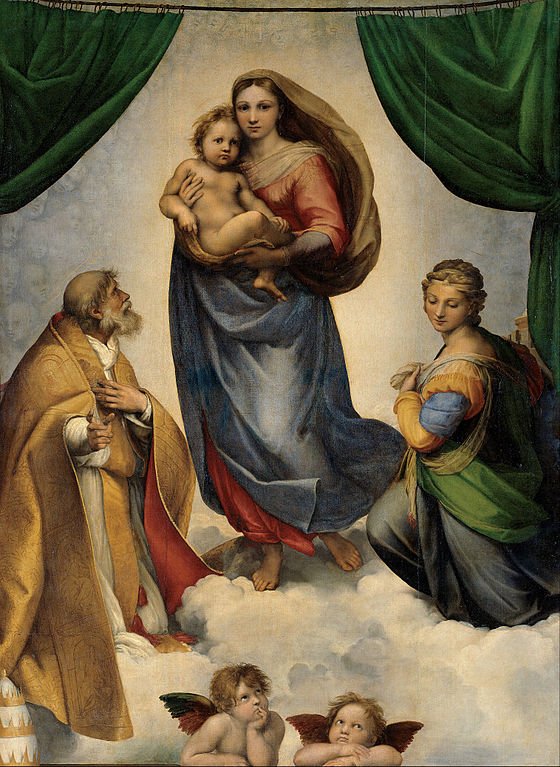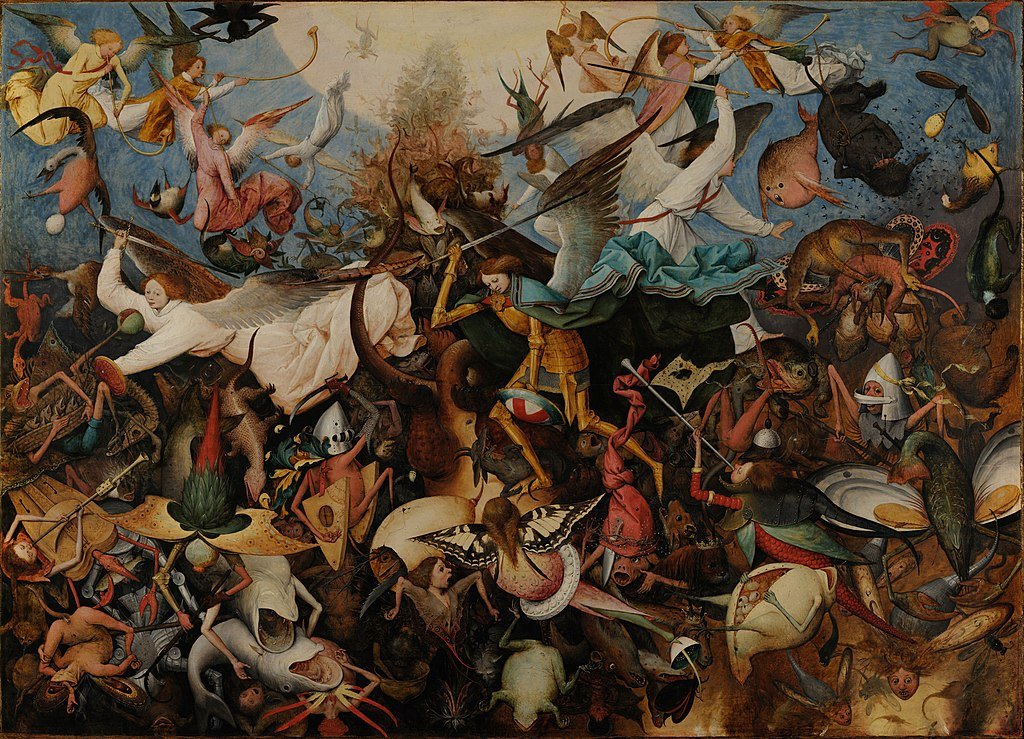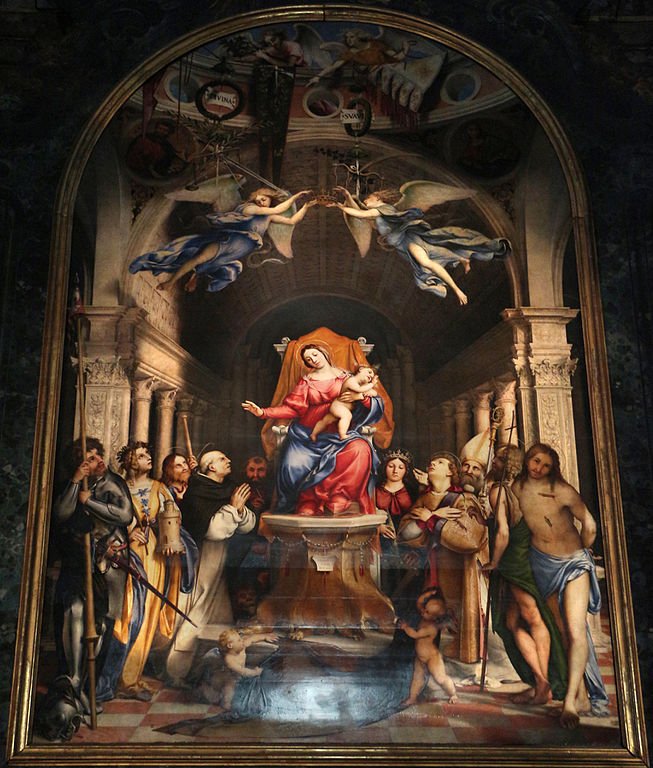The Renaissance period stands as a pinnacle of artistic expression, marked by a profound rediscovery of human creativity, intellect, and spiritual exploration. Among the myriad subjects that captivated the artists of this era, angels held a prominent place, embodying divine beauty, celestial grace, and ethereal majesty. The Renaissance masters skillfully captured the essence of these celestial beings, immortalizing them on canvas in their Renaissance Paintings of Angels.
In this article, we will look through art history to discover the seven most remarkable Renaissance paintings of angels of all time.
Disputation of the Holy Sacrament

Painter: Raphael
Year: 1509-1510
The Disputation of the Sacrament, also known as Disputa, is a renowned painting by the Italian Renaissance artist Raphael, one of the four main artists of the Renaissance. Created between 1509 and 1510, it serves as the initial installment of Raphael’s commission to decorate the rooms now known as the Stanze di Raffaello within the Vatican’s Apostolic Palace.
In this masterpiece, Raphael presents a magnificent scene that encompasses both celestial and earthly realms. Above, Christ is enveloped by a radiant halo, flanked by the Blessed Virgin Mary and John the Baptist on either side. Surrounding them are a host of significant biblical figures, including Peter, Adam, John the Evangelist, King David, Saint Lawrence, Judas Maccabeus, Stephen, Moses, James the Elder, Abraham, and Paul.
God the Father resides above them all, bathed in heavenly golden light, adored by angels. With his right hand raised in blessing, he holds the Earth in his left hand. Beneath Christ’s feet, the Holy Spirit appears in the familiar form of a dove, while putti hold open books of the four Gospels on either side.
The Sistine Madonna

Painter: Raphael
Year: 1513-1514
The Sistine Madonna, also known as the Madonna di San Sisto, is an oil painting created by the renowned Italian artist Raphael. Commissioned in 1512 by Pope Julius II for the church of San Sisto in Piacenza, the artwork was most likely executed around 1513-1514. It stands as one of Raphael’s last Madonna paintings, showcasing his exceptional talent.
Notably, the painting features a prominent element—winged angels positioned beneath Mary—that has gained fame in its own right. These angelic figures, known as putti, are often associated with cherubim. Since as early as 1913, Gustav Kobbé stated that “no cherub or group of cherubs is so famous as the two that lean on the altar top indicated at the very bottom of the picture.” The charming and iconic depiction of these angels adds to the enduring appeal of the painting.
The Annunciation

Painter: Leonardo da Vinci
Year: 1472–1476
The Annunciation is a painting widely attributed to the Italian Renaissance artist Leonardo da Vinci, dated to c. 1472–1476. Leonardo’s earliest extant major work, this painting was completed in Florence while he was an apprentice in the studio of Andrea del Verrocchio. Since 1867 it has been housed in the Uffizi in Florence, the city where it was created. Though the work has been criticized for inaccuracies in its composition, it is among the best-known portrayals of the Annunciation in Christian art.
It depicts the angel Gabriel announcing to Mary that she would conceive miraculously and give birth to a son to be named Jesus and called “the Son of God”, whose reign would never end. The subject of the annunciation was very popular for contemporaneous artworks painted in Christian countries such as Italy and had been depicted many times in Florentine art.
Cherub Playing a Lute

Painter: Rosso Fiorentino
Year: 1521
Cherub Playing Lute, also known as Musical Cherub, is a captivating oil-on-panel painting created in 1521 by Rosso Fiorentino. The artwork currently resides in the Uffizi Gallery in Florence. Signed as “Rubeus Florentinus” and believed to be dated 1521, the precise date remains somewhat unclear. It was introduced to the Uffizi’s Tribuna on June 29, 1605, where it received its present attribution.
Over the years, various inventories from 1635 to 1853 suggested alternative attributions to artists such as Beccafumi and Francesco Vanni. However, an 1825 inventory reaffirmed the painting’s original attribution to Rosso Fiorentino. Originally named Giovanni Battista di Jacopo, Rosso Fiorentino earned his nickname “Rosso Fiorentino” due to his striking red hair, which might have been the inspiration for the red-headed angel depicted in this artwork.
The Fall of the Rebel Angels

Painter: Pieter Bruegel the Elder
Year: 1562
The Fall of the Rebel Angels, painted in 1562 by renowned Netherlandish Renaissance artist Pieter Bruegel the Elder, portrays the banishment of Lucifer and his fallen angelic companions from heaven. Bruegel’s composition showcases a cascading descent of angels and other unearthly creatures, emerging from the sun. Initially attributed to Hieronymus Bosch, this work demonstrates Bruegel’s artistic influences, including Albrecht Dürer, Frans Floris I, and Bosch himself.
The artist drew inspiration from his earlier creations when conceptualizing the various creatures depicted in the painting. Bruegel’s interpretation of the subject matter draws from Revelation 12, where Lucifer’s fall and the subsequent rebellion of the angels are described. The influence of Hieronymus Bosch is evident in the grotesque and distorted figures, portraying hybrid beings that are part-human, part-apocalyptic.
Lucifer, originally a perfect angel, succumbed to pride and rebellion against God’s divine plan, which involved appointing Jesus as the savior of humanity. Leading one-third of the angels in his rebellion, Lucifer sought to assume the role of a new “God.” However, their prideful actions resulted in their expulsion from heaven and triggered the celestial “war in heaven.”
Tobias and the Angel

Painter: Filippino Lippi
Year: 1475–1480
Tobias and the Angel is a captivating oil and tempera painting on a poplar panel created by the Florentine Renaissance painter Filippino Lippi. The artwork depicts a scene from the biblical narrative of Tobias and Raphael. According to the Book of Tobit, Tobias, the son of the blinded Tobit, embarked on a journey from Nineveh to Ecbatana to collect a debt.
Unbeknownst to Tobias, the archangel Raphael assumed the disguise of a human named Azariah and accompanied him on this mission. The painting portrays the two central figures, Tobias and Raphael, walking together through a scenic landscape. They are accompanied by a white dog, and the surroundings feature trees, a river, and a tall tower positioned to the right. The figures are depicted arm in arm, with their blond heads inclined towards each other.
Martinengo Altarpiece

Painter: Lorenzo Lotto
Year: 1513–1516
The Martinengo Altarpiece, completed in 1516, is a notable painting by the esteemed Italian High Renaissance artist Lorenzo Lotto. It currently resides in the church of Santi Bartolomeo e Stefano in Bergamo, located in northern Italy. This masterpiece portrays a Holy Conversation, with the Virgin and Child seated on a majestic throne, encircled by saints.
At the center of the painting, where a dome would traditionally be positioned, we find the tholobate adorned with decorative pendentives featuring Mark and John the Evangelists. From a balustrade, two angels attentively observe the scene, possibly drawing inspiration from Mantegna’s Camera degli Sposi. Additionally, two other angels gracefully hover above Mary, holding her crown. In the foreground, two child angels, a recurring element in Lotto’s works, add a distinctive touch.
